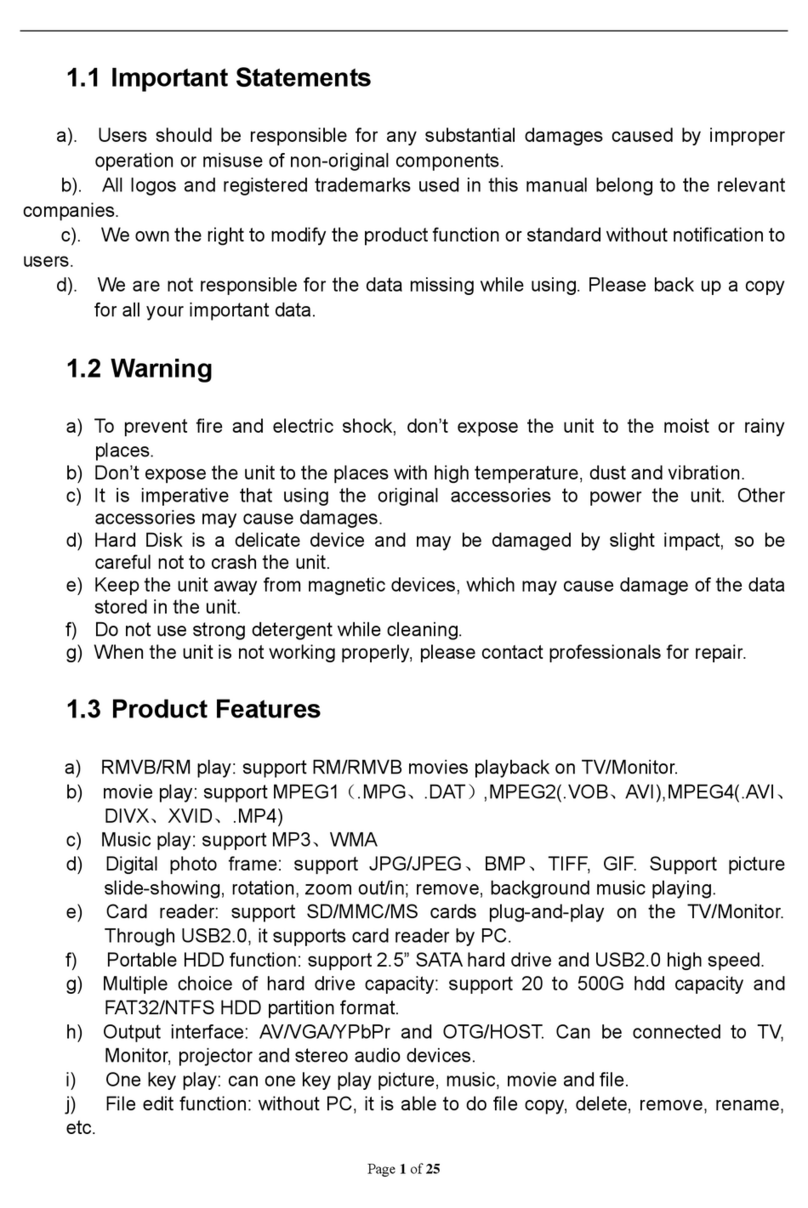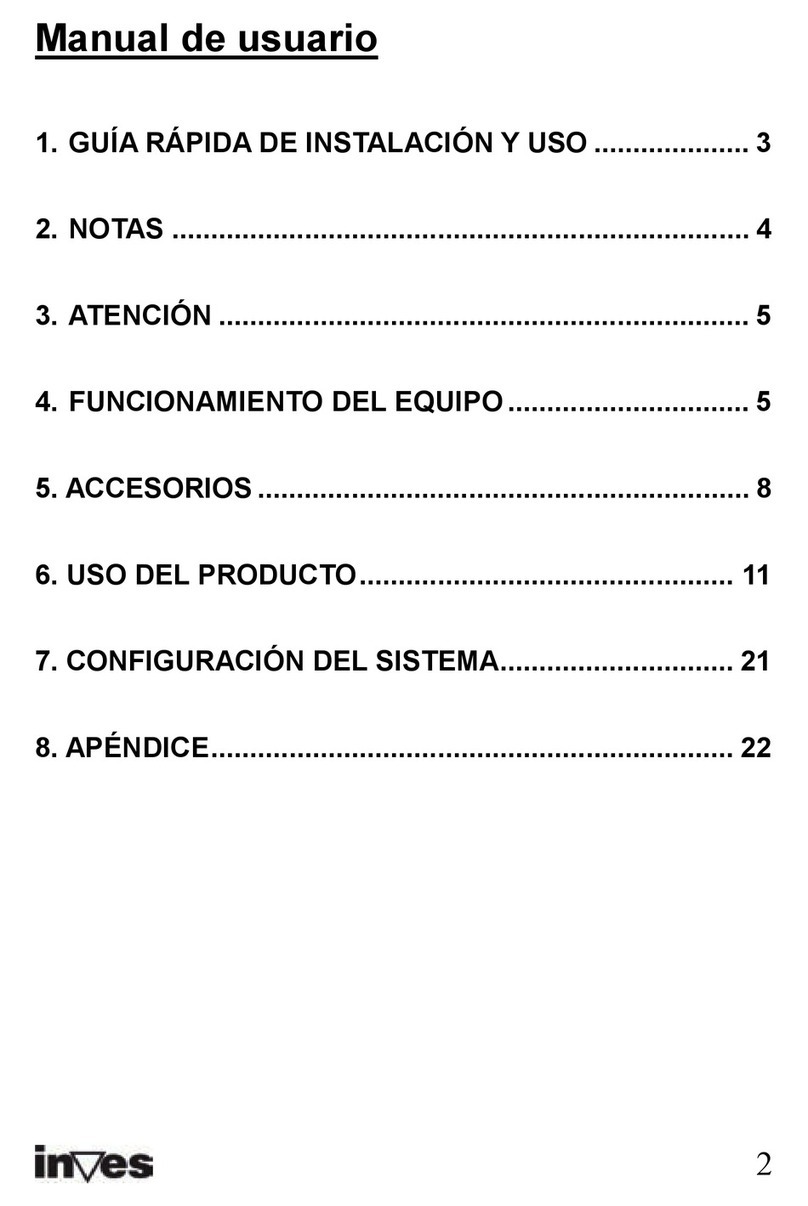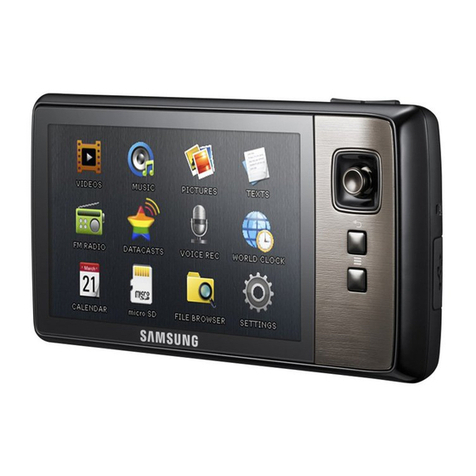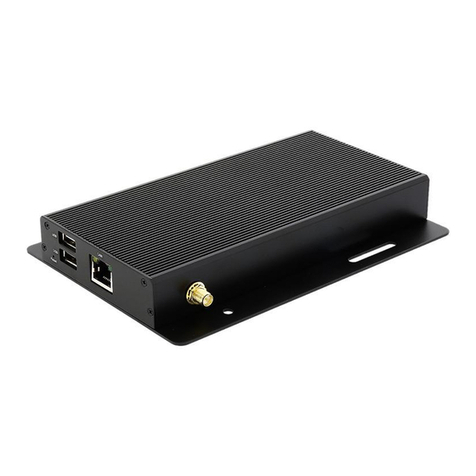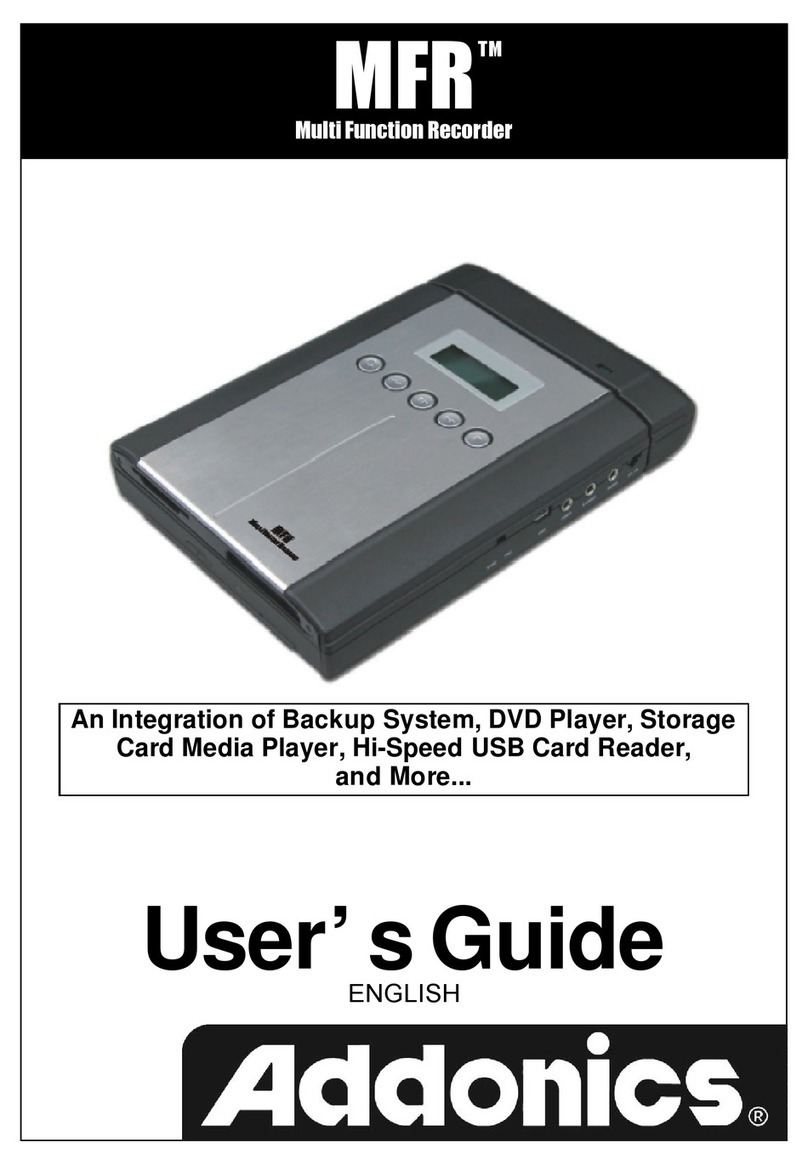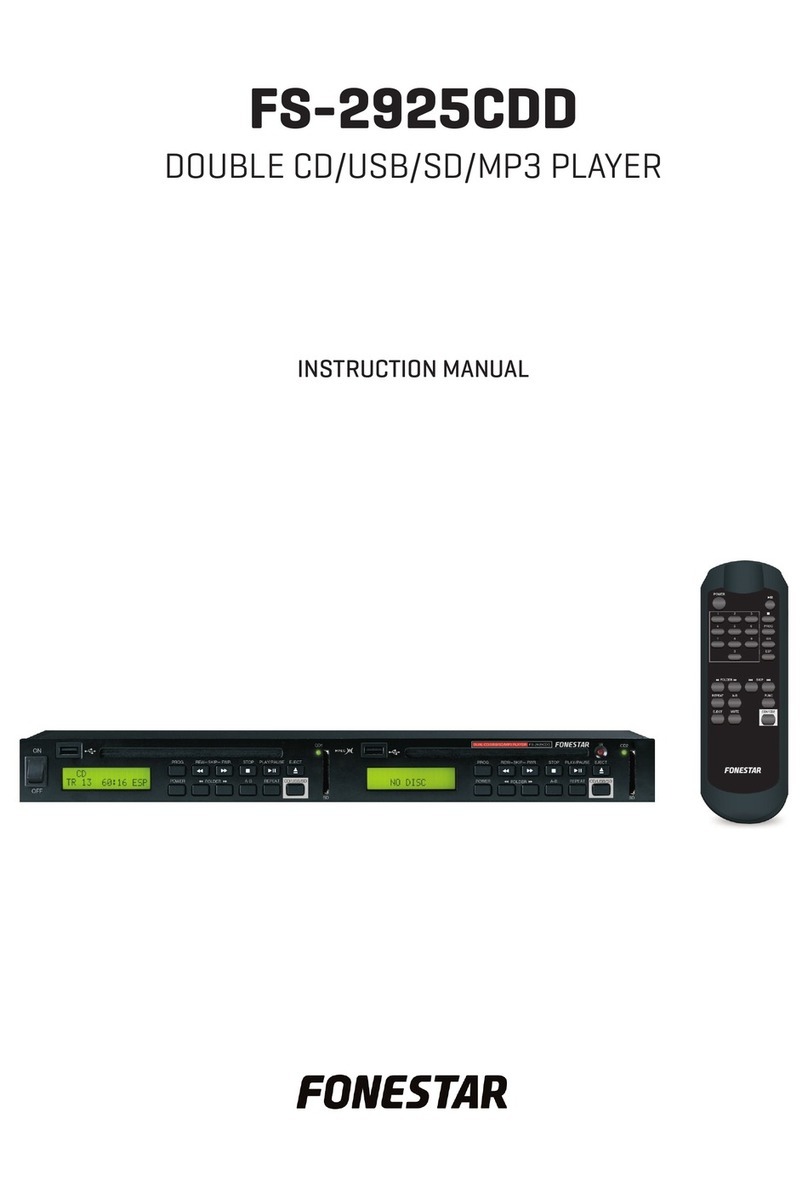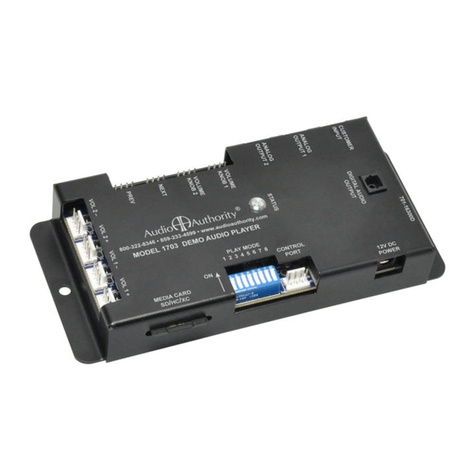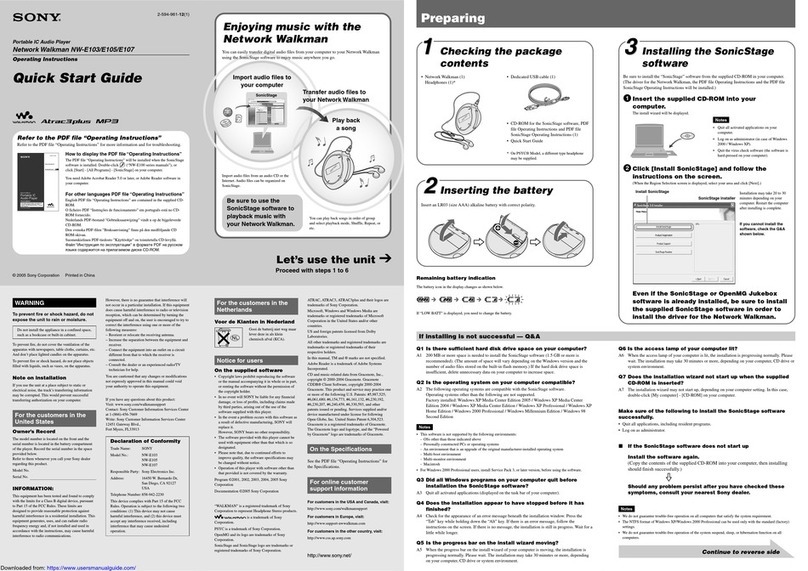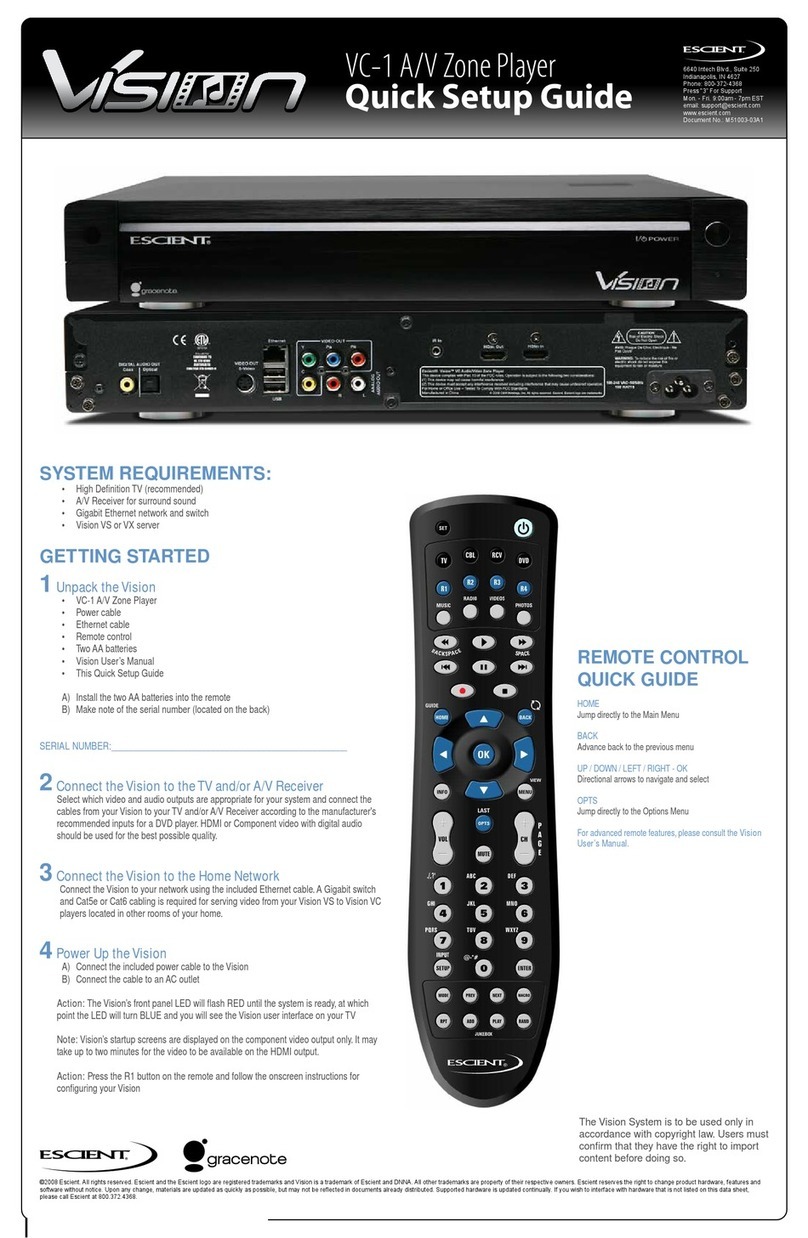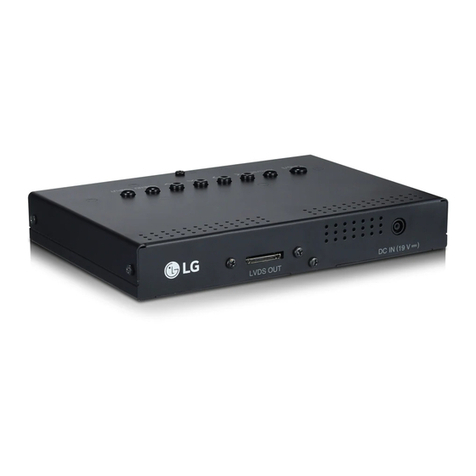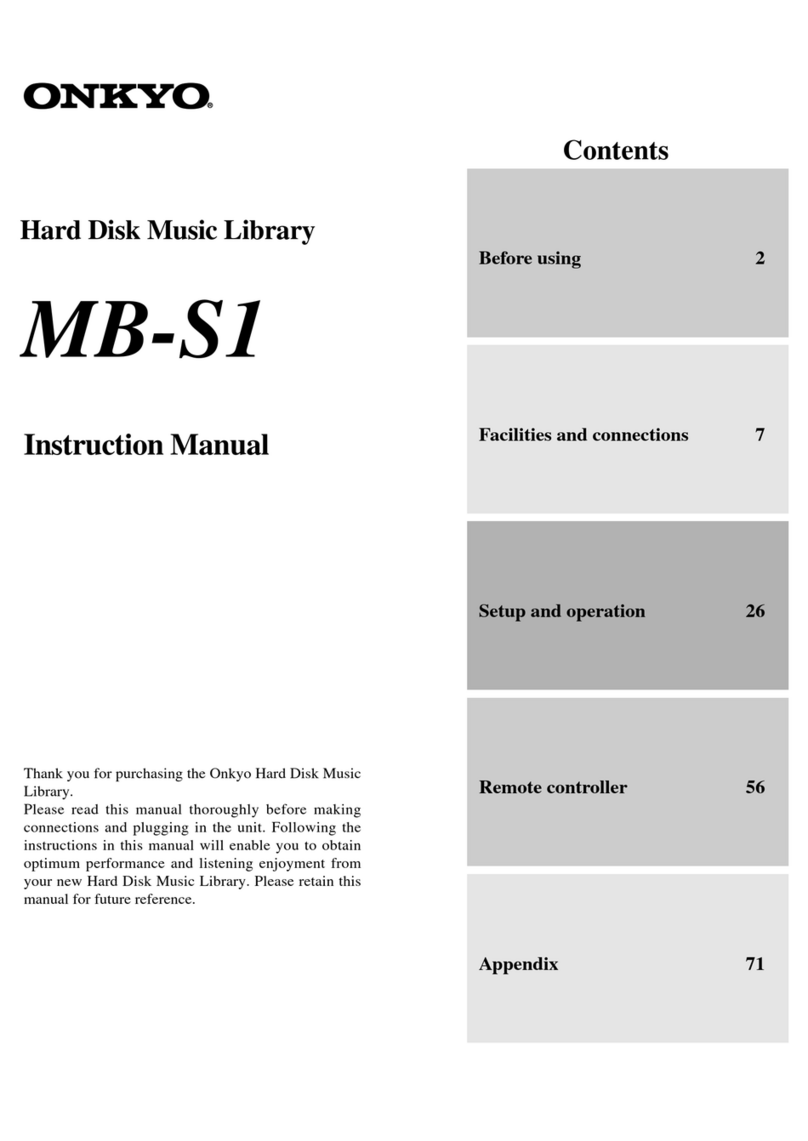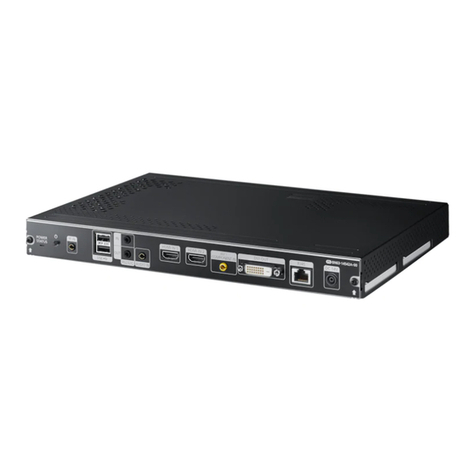Mpio HD 300 User manual

The Rockbox Manual
for
MPIO HD300
rockbox.org
April 30, 2017

2
Rockbox
http://www.rockbox.org/
Open Source Jukebox Firmware
Rockbox and this manual is the collaborative effort of the Rockbox team and
its contributors. See the appendix for a complete list of contributors.
c
2003-2013 The Rockbox Team and its contributors, c
2004 Christi Alice
Scarborough, c
2003 José Maria Garcia-Valdecasas Bernal & Peter Schlenker.
Version 3.14. Built using pdfL
A
T
EX.
Permission is granted to copy, distribute and/or modify this document under
the terms of the GNU Free Documentation License, Version 1.2 or any later
version published by the Free Software Foundation; with no Invariant Sec-
tions, no Front-Cover Texts, and no Back-Cover Texts. A copy of the license
is included in the section entitled “GNU Free Documentation License”.
The Rockbox manual (version 3.14) MPIO HD300

Contents 3
Contents
1. Introduction 11
1.1. Welcome ..................................... 11
1.2. Getting more help ............................... 11
1.3. Naming conventions and marks ........................ 12
2. Installation 13
2.1. Before Starting ................................. 13
2.2. Installing Rockbox ............................... 13
2.2.1. Automated Installation ........................ 14
2.2.2. Manual Installation .......................... 15
2.2.3. Finishing the install .......................... 16
2.2.4. Enabling Speech Support (optional) ................. 16
2.3. Running Rockbox ................................ 17
2.4. Updating Rockbox ............................... 17
2.5. Uninstalling Rockbox ............................. 17
2.5.1. Automatic Uninstallation ....................... 17
2.5.2. Manual Uninstallation ......................... 17
2.6. Troubleshooting ................................. 17
3. Quick Start 19
3.1. Basic Overview ................................. 19
3.1.1. The player’s controls .......................... 19
3.1.2. Turning the player on and off ..................... 19
3.1.3. Starting the original firmware ..................... 20
3.1.4. Putting music on your player ..................... 20
3.1.5. The first contact ............................ 20
3.1.6. Basic controls .............................. 20
3.1.7. Basic concepts ............................. 21
3.2. Customising Rockbox ............................. 21
4. Browsing and playing 22
4.1. File Browser ................................... 22
4.1.1. File Browser Controls ......................... 23
4.1.2. Context Menu ............................. 23
4.1.3. Virtual Keyboard ............................ 25
4.2. Database .................................... 26
4.2.1. Introduction .............................. 26
The Rockbox manual (version 3.14) MPIO HD300

Contents 4
4.2.2. Initializing the Database ........................ 26
4.2.3. The Database Menu .......................... 26
4.2.4. Using the Database .......................... 27
4.3. While Playing Screen .............................. 28
4.3.1. WPS Key Controls ........................... 29
4.3.2. Peak Meter ............................... 29
4.3.3. The WPS Context Menu ....................... 30
4.4. Working with Playlists ............................. 33
4.4.1. Playlist terminology .......................... 33
4.4.2. Creating playlists ............................ 33
4.4.3. Adding music to playlists ....................... 35
4.4.4. Modifying playlists ........................... 36
4.4.5. Saving playlists ............................. 36
4.4.6. Loading saved playlists ........................ 37
5. The Main Menu 38
5.1. Introducing the Main Menu .......................... 38
5.2. Navigating the Main Menu .......................... 38
5.3. Recent Bookmarks ............................... 39
5.4. Files ....................................... 39
5.5. Database .................................... 40
5.6. Now Playing/Resume Playback ........................ 40
5.7. Settings ..................................... 40
5.7.1. Sound Settings ............................. 40
5.7.2. Playback Settings ........................... 40
5.7.3. General Settings ............................ 40
5.7.4. Theme Settings ............................. 40
5.7.5. Recording Settings ........................... 40
5.7.6. Manage Settings ............................ 41
5.8. Recording .................................... 41
5.8.1. While Recording Screen ........................ 41
5.9. FM Radio .................................... 42
5.10. Playlists ..................................... 43
5.11. Plugins ..................................... 44
5.12. System ...................................... 44
5.13. Shortcuts .................................... 45
6. Sound Settings 47
6.1. Volume ..................................... 47
6.2. Bass ....................................... 47
6.3. Volume Limit .................................. 47
6.4. Treble ...................................... 48
6.5. Balance ..................................... 48
6.6. Channels .................................... 48
The Rockbox manual (version 3.14) MPIO HD300

Contents 5
6.7. Stereo Width .................................. 48
6.8. 3D Enhancement ................................ 49
6.9. Crossfeed .................................... 49
6.10. Equalizer .................................... 50
6.11. Dithering .................................... 52
6.12. Timestretch ................................... 53
6.13. Haas Surround ................................. 53
6.14. Perceptual Bass Enhancement ......................... 53
6.15. Auditory Fatigue Reduction .......................... 54
6.16. Compressor ................................... 54
7. Playback Settings 55
7.1. Shuffle ...................................... 55
7.2. Repeat ...................................... 55
7.3. Play Selected First ............................... 56
7.4. Fast-Forward/Rewind ............................. 56
7.5. Anti-Skip Buffer ................................ 56
7.6. Fade on Stop/Pause .............................. 56
7.7. Party Mode ................................... 56
7.8. Crossfade .................................... 56
7.9. Replaygain ................................... 58
7.10. Track Skip Beep ................................ 59
7.11. Auto-Change Directory ............................ 59
7.12. Constrain Auto-Change ............................ 59
7.13. Last.fm Log ................................... 59
7.14. Cuesheet Support ................................ 60
7.15. Skip Length ................................... 60
7.16. Prevent Track Skipping ............................ 60
7.17. Rewind Before Resume ............................. 60
7.18. Rewind on Pause ................................ 61
8. General Settings 62
8.1. Playlist ..................................... 62
8.2. File View .................................... 62
8.3. Database .................................... 64
8.4. Display ..................................... 64
8.5. System ...................................... 67
8.5.1. Battery ................................. 67
8.5.2. Disk ................................... 67
8.5.3. Limits .................................. 68
8.5.4. Car Adapter Mode ........................... 68
8.5.5. Keyclick ................................. 68
8.5.6. Advanced Key Lock .......................... 69
The Rockbox manual (version 3.14) MPIO HD300

Contents 6
8.6. Startup/Shutdown ............................... 69
8.6.1. Start Screen ............................... 69
8.6.2. Idle Poweroff .............................. 70
8.6.3. Sleep Timer ............................... 70
8.7. Bookmarking .................................. 71
8.8. Automatic resume ............................... 72
8.9. Language .................................... 73
8.10. Voice ....................................... 73
9. Theme Settings 76
10.Recording Settings 78
10.1. Format ...................................... 78
10.2. Encoder Settings (MP3 only) ......................... 78
10.3. Frequency .................................... 78
10.4. Source ...................................... 79
10.5. Channels .................................... 79
10.6. Mono Mode ................................... 79
10.7. File Split Options ................................ 79
10.8. Prerecord Time ................................. 79
10.9. Clear Recording Directory ........................... 80
10.10.Clipping Light ................................. 80
10.11.Trigger ...................................... 80
11.Time and Date 82
12.Plugins 83
12.1. Games ...................................... 83
12.1.1. 2048 ................................... 83
12.1.2. Blackjack ................................ 84
12.1.3. Boomshine ............................... 85
12.1.4. BrickMania ............................... 85
12.1.5. Bubbles ................................. 86
12.1.6. Chessbox ................................ 86
12.1.7. Chopper ................................. 87
12.1.8. Dice ................................... 88
12.1.9. Doom .................................. 88
12.1.10.Flipit .................................. 90
12.1.11.Goban .................................. 91
12.1.12.Invadrox ................................. 95
12.1.13.Jackpot ................................. 96
12.1.14.Jewels .................................. 96
12.1.15.Maze ................................... 97
12.1.16.MazezaM ................................ 97
The Rockbox manual (version 3.14) MPIO HD300

Contents 7
12.1.17.Minesweeper .............................. 98
12.1.18.Pegbox ................................. 99
12.1.19.Pong ................................... 99
12.1.20.Puzzles .................................100
12.1.21.Reversi .................................100
12.1.22.Robotfindskitten ............................101
12.1.23.Rockblox ................................101
12.1.24.Rockblox1d ...............................102
12.1.25.Sliding Puzzle ..............................102
12.1.26.Snake ..................................103
12.1.27.Snake 2 .................................104
12.1.28.Sokoban .................................104
12.1.29.Solitaire .................................105
12.1.30.Spacerocks ...............................106
12.1.31.Star ...................................107
12.1.32.Sudoku .................................108
12.1.33.Superdom ................................109
12.1.34.Wormlet .................................110
12.1.35.Xobox ..................................113
12.1.36.XWorld .................................113
12.2. Demos ......................................114
12.2.1. Bounce .................................114
12.2.2. Credits .................................115
12.2.3. Cube ...................................115
12.2.4. Demystify ................................116
12.2.5. FFT ...................................116
12.2.6. Fire ...................................116
12.2.7. Fractals .................................117
12.2.8. Logo ...................................117
12.2.9. Matrix ..................................118
12.2.10.Mosaique ................................118
12.2.11.Oscilloscope ...............................119
12.2.12.PictureFlow ...............................120
12.2.13.Plasma .................................121
12.2.14.Rocklife .................................122
12.2.15.Snow ...................................122
12.2.16.Starfield .................................123
12.2.17.VU meter ................................123
12.3. Viewers .....................................124
12.3.1. Shortcuts ................................124
12.3.2. Chip-8 Emulator ............................125
12.3.3. Frotz ...................................126
12.3.4. Image Viewer ..............................127
12.3.5. Lua scripting language .........................128
The Rockbox manual (version 3.14) MPIO HD300

Contents 8
12.3.6. Midiplay .................................129
12.3.7. MPEG Player ..............................129
12.3.8. MP3 Encoder ..............................131
12.3.9. Rockboy .................................132
12.3.10.Search ..................................133
12.3.11.Shopper .................................133
12.3.12.Sort ...................................134
12.3.13.Speedread ................................135
12.3.14.Text Viewer ...............................135
12.3.15.Theme Remove .............................139
12.3.16.VBRfix .................................140
12.3.17.ZXBox ..................................140
12.4. Applications ...................................142
12.4.1. Alarm Clock ..............................142
12.4.2. Battery Benchmark ..........................142
12.4.3. Calculator ................................144
12.4.4. Calendar ................................145
12.4.5. Chess Clock ...............................145
12.4.6. Clock ..................................147
12.4.7. Dict ...................................149
12.4.8. Disk Tidy ................................149
12.4.9. Keybox .................................150
12.4.10.Lamp ..................................150
12.4.11.Lrcplayer ................................151
12.4.12.Main Menu Configuration .......................154
12.4.13.md5sum .................................154
12.4.14.Metronome ...............................154
12.4.15.One-Time Password Client ......................158
12.4.16.Advanced Settings ...........................159
12.4.17.Periodic Table .............................159
12.4.18.Pitch Detector .............................159
12.4.19.Random Folder Advance Configuration ...............159
12.4.20.Resistor Calculator ...........................160
12.4.21.Stats ...................................161
12.4.22.Stopwatch ................................162
12.4.23.Text Editor ...............................162
13.Advanced Topics 164
13.1. Customising the User Interface ........................164
13.1.1. Customising The Main Menu .....................164
13.1.2. Getting Extras .............................164
13.1.3. Loading Fonts .............................164
13.1.4. Loading Languages ...........................165
13.1.5. Loading Backdrops ...........................165
The Rockbox manual (version 3.14) MPIO HD300

Contents 9
13.1.6. UI Viewport ..............................165
13.2. Configuring the Theme .............................166
13.2.1. Themeing – General Info .......................166
13.2.2. Themes – Create Your Own ......................166
13.2.3. Info Viewport (SBS only) .......................169
13.2.4. Additional Fonts ............................169
13.3. Managing Rockbox Settings ..........................172
13.3.1. Introduction to .cfg Files .......................172
13.3.2. Specifications for .cfg Files ......................172
13.3.3. The Manage Settings menu ....................173
13.4. Firmware Loading ...............................174
13.4.1. Using ROLO (Rockbox Loader) ....................174
13.5. Optimising battery runtime ..........................174
13.5.1. Display backlight ............................174
13.5.2. Anti-Skip Buffer ............................174
13.5.3. Replaygain ...............................175
13.5.4. Peak Meter ...............................175
13.5.5. Audio format and bitrate .......................175
13.5.6. Sound settings .............................175
A. File formats 176
A.1. Supported file formats .............................176
B. Audio and metadata formats 177
B.1. Supported audio formats ............................177
B.1.1. Lossy Codecs ..............................177
B.1.2. Lossless Codecs .............................178
B.1.3. Other Codecs ..............................179
B.1.4. Codec featureset ............................180
B.2. Supported metadata tags ...........................181
B.2.1. Featureset for generic metadata tags .................181
B.2.2. Featureset for codec specific metadata ................182
B.2.3. Limitations of metadata handling ...................182
C. Album Art 183
C.1. Limitations ...................................183
C.2. Where to put album art ............................183
D. Theme Tags 185
D.1. Status Bar ....................................185
D.2. Hardware Capabilities .............................185
D.3. Information from the track tags ........................186
D.4. Viewports ....................................186
D.5. Additional Fonts ................................187
The Rockbox manual (version 3.14) MPIO HD300

Contents 10
D.6. Misc Coloring Tags ...............................187
D.7. Power Related Information ..........................187
D.8. Information about the file ...........................188
D.9. Playlist/Song Info ...............................189
D.10.Playlist Viewer .................................189
D.11.Runtime Database ...............................190
D.12.Sound (DSP) settings .............................190
D.13.Hold .......................................190
D.14.Virtual LED ..................................191
D.15.Repeat Mode ..................................191
D.16.Playback Mode .................................191
D.17.Current Screen .................................191
D.18.List Title (.sbs only) .............................192
D.19.Changing Volume ................................193
D.20.Settings .....................................193
D.21.Images ......................................194
D.21.1.How to display the album art .....................195
D.22.FM Radio ....................................196
D.23.Alignment and language direction .......................197
D.24.Conditional Tags ................................197
D.25.Subline Tags ..................................198
D.26.Time and Date .................................198
D.27.Text Translation ................................199
D.28.Bar Tags .....................................199
D.28.1.Options .................................199
D.29.Other Tags ...................................200
E. Config file options 202
F. Menu Overview 207
G. User feedback 208
G.1. Bug reports ...................................208
G.1.1. Rules for submitting new bug reports ................208
G.2. Feature ideas ..................................208
G.2.1. Rules for submitting a new feature idea ...............208
G.2.2. Features we will not implement ....................209
H. Credits 210
I. Licenses 214
I.1. GNU Free Documentation License ......................214
I.2. The GNU General Public License .......................222
The Rockbox manual (version 3.14) MPIO HD300

Chapter 1. Introduction 11
1. Introduction
1.1. Welcome
This is the manual for Rockbox. Rockbox is an open source firmware replacement
for a growing number of digital audio players. Rockbox aims to be considerably more
functional and efficient than your device’s stock firmware while remaining easy to use
and customisable. Rockbox is written by users, for users. Not only is it free to use, it
is also released under the GNU General Public License (GPL), which means that it will
always remain free both to use and to change.
Rockbox has been in development since 2001, and receives new features, tweaks and
fixes each day to provide you with the best possible experience on your digital audio
player. A major goal of Rockbox is to be simple and easy to use, yet remain very
customisable and configurable. We believe that you should never need to go through a
series of menus for an action you perform frequently. We also believe that you should
be able to configure almost anything about Rockbox you could want, pertaining to
functionality. Another top priority of Rockbox is audio playback quality – Rockbox,
for most models, includes a wider range of sound settings than the device’s original
firmware. A lot of work has been put into making Rockbox sound the best it can, and
improvements are constantly being made. All models have access to a large number
of plugins, including many games, applications, and graphical “demos”. You can load
different configurations quickly for different purposes (e.g. a large font for in your car,
different sound settings for at home). Rockbox features a very wide range of languages,
and all supported models also have the ability to talk to you – menus can be voiced and
filenames spelled out or spoken.
1.2. Getting more help
This manual is intended to be a comprehensive introduction to the Rockbox firmware.
There is, however, more help available. The Rockbox website at http://www.rockbox.org/
contains very extensive documentation and guides written by members of the Rockbox
community and this should be your first port of call when looking for further help.
If you cannot find the information you are searching for on the Rockbox website there
are a number of support channels you should have a look at. You can try the Rockbox
forums located at http://forums.rockbox.org/. The mailing lists are another option, and
can be found at http://www.rockbox.org/mail/. From that page you can subscribe to
the lists and browse the archives. To search the list archives simply use the search field
that is located on the left side of the website. Furthermore, you can ask on IRC. The
The Rockbox manual (version 3.14) MPIO HD300

Chapter 1. Introduction 12
main channel for Rockbox is #rockbox on irc://irc.freenode.net. Many helpful developers
and users are usually around. Just join and ask your question (don’t ask to ask!) – if
someone knows the answer you’ll usually get an answer pretty quickly. More information
including IRC logs can be found at http://www.rockbox.org/irc/. We also have a web
client so that you can join the Rockbox IRC channel without needing to install additional
software onto your computer.
If you think you have found a bug please make sure it actually is a bug and is still
present in the most recent version of Rockbox. You should try to confirm that by using
the above mentioned support channels first. After that you can submit that issue to our
tracker. Refer to section G(page 208) for details on how to use the tracker.
1.3. Naming conventions and marks
We have some conventions (especially for naming) that are intended to be consistent
throughout this manual.
Manufacturer and product names are formatted in accordance with the standard rules
of English grammar, e.g. “MPIO playback is currently unsupported”. Manufacturer and
model names are proper nouns, and thus are written beginning with a capital letter.
This manual has some parts that are marked with icons on the margin to help you
finding important parts or parts you could skip. The following icons are used:
Note: This indicates a note. A note starts always with the text “Note”. In order to b
make finding notes easier each one is accompanied by an icon in the margin as here.
Notes are used to mark useful information that may help you to get the most out of
Rockbox.
Warning: This is a warning. In contrast to notes mentioned above, a warning should !
be taken more seriously. Whereas ignoring notes will not cause any serious damage,
ignoring warnings could cause serious damage to your player. You really should read the
warnings, especially if you are new to Rockbox.
This icon marks a section that is intended especially for the blind and visually im- ¸
paired. As they cannot read the manual in the same way sighted people do we have
added some additional descriptions. If you are not blind or visually impaired you can
probably completely skip these blocks. To make this easier, there is an icon shown in
the margin on the right.
Links to the wiki are abbreviated by the name of the wiki page. Those names are still
linked so you can simply follow them like any other link in this manual. If you want to
access a wiki page manually go to Zhttp://www.rockbox.org/wiki/ and type the page
name in the “Go” box at the top of the page. Links to wiki pages are also indicated by
the symbol Zin front of the page name.
The Rockbox manual (version 3.14) MPIO HD300

Chapter 2. Installation 13
2. Installation
Installing Rockbox is generally a quick and easy procedure. However before beginning
there are a few important things to know.
2.1. Before Starting
USB connection. To transfer Rockbox to your player you need to connect it to your
computer. For manual installation/uninstallation, or should autodetection fail
during automatic installation, you need to know where to access the player. On
Windows this means you need to know the drive letter associated with the player.
On Linux you need to know the mount point of your player. On Mac OS X you
need to know the volume name of your player.
2.2. Installing Rockbox
There are two ways to install Rockbox: automated and manual. The automated way is
the preferred method of installing Rockbox for the majority of people. Rockbox Utility
is a graphical application that does almost everything for you. However, should you
encounter a problem, then the manual way is still available to you.
There are two separate components which need to be installed in order to run Rockbox:
The Rockbox bootloader. The bootloader is the program that tells your player how
to load and start other components of Rockbox and for providing the dual boot
function. This is the component of Rockbox that is installed to the flash memory
of your MPIO.
The Rockbox firmware. Unlike the MPIO firmware, which runs entirely from flash
memory, most of the Rockbox code is contained in a “build” that resides on
your player’s drive. This makes it easy to update Rockbox. The build consists of
a directory called .rockbox which contains all of the Rockbox files, and is located
in the root of your player’s drive.
Apart from the required parts there are some addons you might be interested in
installing.
Fonts. Rockbox can load custom fonts. The fonts are distributed as a separate package
and thus need to be installed separately. They are not required to run Rockbox
itself but a lot of themes require the fonts package to be installed.
The Rockbox manual (version 3.14) MPIO HD300

Chapter 2. Installation 14
Themes. The appearance of Rockbox can be customised by themes. Depending on your
taste you might want to install additional themes to change the look of Rockbox.
2.2.1. Automated Installation
To automatically install Rockbox, download the official installer and housekeeping tool
Rockbox Utility. It allows you to:
•Automatically install all needed components for using Rockbox (“Minimal Instal-
lation”).
•Automatically install all suggested components (“Complete Installation”).
•Selectively install optional components.
•Install additional fonts and themes.
•Install voice files and generate talk clips.
•Uninstall all components you installed using Rockbox Utility.
Prebuilt binaries for Windows, Linux and Mac OS X are available at the ZRockboxUtility
wiki page.
When first starting Rockbox Utility run “Autodetect”, found in the configuration
dialog (File →Configure). Autodetection can detect most player types. If autodetection
fails or is unable to detect the mountpoint, make sure to enter the correct values. The
mountpoint indicates the location of the player in your filesystem. On Windows, this is
the drive letter the player gets assigned, on other systems this is a path in the filesystem.
Rockbox Utility will ask you for a compatible copy of the original firmware. This is
because for legal reasons we cannot distribute the bootloader directly. Instead, we have
to patch the MPIO firmware with the Rockbox bootloader.
Download a supported version of the MPIO firmware for your MPIO HD300 from the
MPIO website, links can be found on ZMPIOHD300Port.
Warning: The only tested version of the original firmware is 1.30.06 and as such is the !
only supported version
If the file that you downloaded is a .zip file, use an unzip utility like mentioned in the
prerequisites section to extract the .SYS from the .zip file to your desktop. Likewise, if
the file that you downloaded is an .exe file, double-click on the .exe file to extract the
.SYS file to your desktop. When running Linux you should be able to extract .exe files
using unzip.
Choosing a Rockbox version
There are three different versions of Rockbox available from the Rockbox website: Re-
lease version, current build and archived daily build. You need to decide which one you
The Rockbox manual (version 3.14) MPIO HD300

Chapter 2. Installation 15
want to install and get the appropriate version for your player. If you select either “Min-
imal Installation” or “Complete Installation” from the “Quick Start” tab, then Rockbox
Utility will automatically install the release version of Rockbox. Using the “Installation”
tab will allow you to select which version you wish to install.
Release. The release version is the latest stable release, free of known critical bugs.
For a manual install, the current stable release of Rockbox is available at http:
//www.rockbox.org/download/.
Development Build. The development build is built at each change to the Rockbox
source code repository and represents the current state of Rockbox development.
This means that the build could contain bugs but most of the time is safe to use.
For a manual install, you can download the current build from http://build.rockbox.
org/.
Archived Build. In addition to the release version and the current build, there is also
an archive of daily builds available for download. These are built once a day from
the latest source code in the repository. For a manual install, you can download
archived builds from http://www.rockbox.org/daily.shtml.
Note: Because current and archived builds are development versions that change fre- b
quently, they may behave differently than described in this manual, or they may in-
troduce new (and potentially annoying) bugs. Unless you wish to try the latest and
greatest features at the price of possibly greater instability, or you wish to help with
development, you should stick with the release.
Please now go to section 2.2.3 (page 16) to complete the installation procedure.
2.2.2. Manual Installation
The manual installation method is still available to you, should you need or desire it by
following the instructions below. If you have used Rockbox Utility to install Rockbox,
then you do not need to follow the next section and can skip straight to section 2.2.3
(page 16)
Installing the firmware
1. Download your chosen version of Rockbox from the links in the previous section.
2. Connect your player to the computer via USB as described in the manual that
came with your player.
3. Take the .zip file that you downloaded and use the “Extract all” command of
your unzip program to extract the files onto your player.
The Rockbox manual (version 3.14) MPIO HD300

Chapter 2. Installation 16
Note: The entire contents of the .zip file should be extracted directly to the root of b
your player’s drive. Do not try to create a separate directory on your player for the
Rockbox files! The .zip file already contains the internal structure that Rockbox needs.
If the contents of the .zip file are extracted correctly, you will have a directory called
.rockbox, which contains all the files needed by Rockbox, in the main directory of your
player’s drive.
Installing the bootloader
Installing the bootloader is the trickiest part of the installation. As explained above, we
cannot distribute the bootloader directly, and thus need to patch a compatible version
of the MPIO firmware, which can be downloaded as described above.
1. Download official Rockbox bootloader for MPIO HD300 from http://download.
rockbox.org/bootloader/mpio/hd300 and save it to your desktop. The archive con-
tains three files: bootloader.mpio, bootloader.map and rockbox-info.txt. The first
file is actual bootloader, two others can be used for debugging and are irrelevant
for end user.
2. Download mkmpioboot utility from http://download.rockbox.org/bootloader/mpio/
mkmpioboot
3. Process previously downloaded official firmware to include rockbox bootloader.
Open terminal window and type the following command:
Code
mkmpioboot HD300_UPG.SYS bootloader.mpio HD300_UPG.rb
4. Copy HD300_UPG.rb to the SYSTEM folder of your player and rename back to
HD300_UPG.SYS
5. Safe eject your player
6. Connect Wall charger and turn on the device. This should trigger firmware upgrade
process which will install rockbox bootloader to the flash memory of the player.
2.2.3. Finishing the install
2.2.4. Enabling Speech Support (optional)
If you wish to use speech support you will also need a voice file. Voice files allow Rockbox
to speak the user interface to you. Rockbox Utility can install an English voice file, or
you can download it from http://www.rockbox.org/daily.shtml and unzip it to the root
of your player. Rockbox Utility can also aid you in the creation of voice files with
different voices or in other languages if you have a suitable speech engine installed on
your computer. Voice menus are enabled by default and will come into effect after a
The Rockbox manual (version 3.14) MPIO HD300

Chapter 2. Installation 17
reboot. See section 8.10 (page 73) for details on voice settings. Rockbox Utility can also
aid in the production of talk files, which allow Rockbox to speak file and folder names.
2.3. Running Rockbox
When you turn the unit on, Rockbox should load.
2.4. Updating Rockbox
Rockbox can be easily updated with Rockbox Utility. You can also update Rockbox
manually – download a Rockbox build as detailed above, and unzip the build to the root
directory of your player as in the manual installation stage. If your unzip program asks
you whether to overwrite files, choose the “Yes to all” option. The new build will be
installed over your current build.
The bootloader only changes rarely, and should not normally need to be updated.
Note: If you use Rockbox Utility be aware that it cannot detect manually installed b
components.
2.5. Uninstalling Rockbox
Note: The Rockbox bootloader allows you to choose between Rockbox and the original b
firmware. (See section 3.1.3 (page 20) for more information.)
2.5.1. Automatic Uninstallation
You can uninstall Rockbox automatically by using Rockbox Utility. If you installed
Rockbox manually you can still use Rockbox Utility for uninstallation but will not be
able to do this selectively.
2.5.2. Manual Uninstallation
If you wish to clean up your disk, you may also wish to delete the .rockbox directory
and its contents. Turn the MPIO off. Turn the player back on and the original MPIO
software will load.
2.6. Troubleshooting
“File Not Found” If you receive a “File Not Found” from the bootloader, then the
bootloader cannot find the Rockbox firmware. This is usually a result of not
The Rockbox manual (version 3.14) MPIO HD300

Chapter 2. Installation 18
extracting the contents of the .zip file to the proper location, and should not
happen when Rockbox has been installed with Rockbox Utility.
To fix this, either install Rockbox with the Rockbox Utility which will take care
of this for you, or recheck the Manual Install section to see where the files need to
be located.
The Rockbox manual (version 3.14) MPIO HD300

Chapter 3. Quick Start 19
3. Quick Start
3.1. Basic Overview
3.1.1. The player’s controls
PlayRecord
Enter
Menu
Rewind Forward
Hold
Slider
Throughout this manual, the buttons on the player are labelled according to the
picture above. Whenever a button name is prefixed by “Long”, a long press of approx-
imately one second should be performed on that button. The buttons are described in
detail in the following paragraph. Additional information for blind users is available on ¸
the Rockbox website at ZBlindFAQ.
3.1.2. Turning the player on and off
To turn on and off your Rockbox enabled player use the following keys:
Key Action
Long Play Start Rockbox
Long Play Shutdown Rockbox
The Rockbox manual (version 3.14) MPIO HD300

Chapter 3. Quick Start 20
On shutdown, Rockbox automatically saves its settings.
In the unlikely event of a software failure, a hardware reset can be performed by
inserting a paperclip gently into the Reset hole.
3.1.3. Starting the original firmware
Rockbox has a dual-boot feature. To boot into the original firmware, when the player is
turned off, press and hold the Rec button, and then press the Play button. This will
bring you to the short menu where you can choose among: Boot Rockbox, Boot MPIO
firmware and Shutdown. Select the option you need with Rewind and Forward and
confirm with long Play.
3.1.4. Putting music on your player
With the player connected to the computer as an MSC/UMS device (like a USB Drive),
music files can be put on the player via any standard file transfer method that you would
use to copy files between drives (e.g. Drag-and-Drop). Files may be placed wherever
you like on the player, but it is strongly suggested NOT to put them in the /.rockbox
folder and instead put them in any other folder, e.g. /,/music or /audio. The default
directory structure that is assumed by some parts of Rockbox (album art searching, and
missing-tag fallback in some WPSes) uses the parent directory of a song as the Album
name, and the parent directory of that folder as the Artist name. WPSes may display
information incorrectly if your files are not properly tagged, and you have your music
organized in a way different than they assume when attempting to guess the Artist and
Album names from your filetree. See section C(page 183) for the requirements for
Album Art to work properly. See section B.1 (page 177) for a list of supported audio
formats.
3.1.5. The first contact
After you have first started the player, you’ll be presented by the Main Menu. From
this menu you can reach every function of Rockbox, for more information (see section 5.1
(page 38)). To browse the files on your player, select Files (see section 4.1 (page 22)),
and to browse in a view that is based on the meta-data1of your audio files, select
Database (see section 4.2 (page 26)).
3.1.6. Basic controls
When browsing files and moving through menus you usually get a list view presented.
The navigation in these lists are usually the same and should be pretty intuitive. In the
tree view use Scroll Down and Scroll Up to move around the selection. Use Enter to
select an item. When browsing the file system selecting an audio file plays it. The view
switches to the “While playing screen”, usually abbreviated as “WPS” (see section 4.3
1ID3 Tags, Vorbis comments, etc.
The Rockbox manual (version 3.14) MPIO HD300
Other manuals for HD 300
1
Table of contents
Popular Media Player manuals by other brands
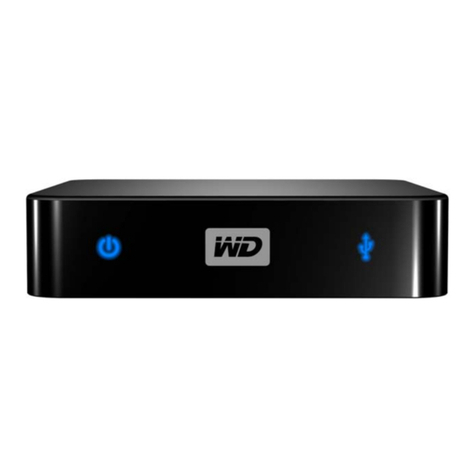
Western Digital
Western Digital WDBAAL0000NBK - TV Mini - Digital AV Player user manual
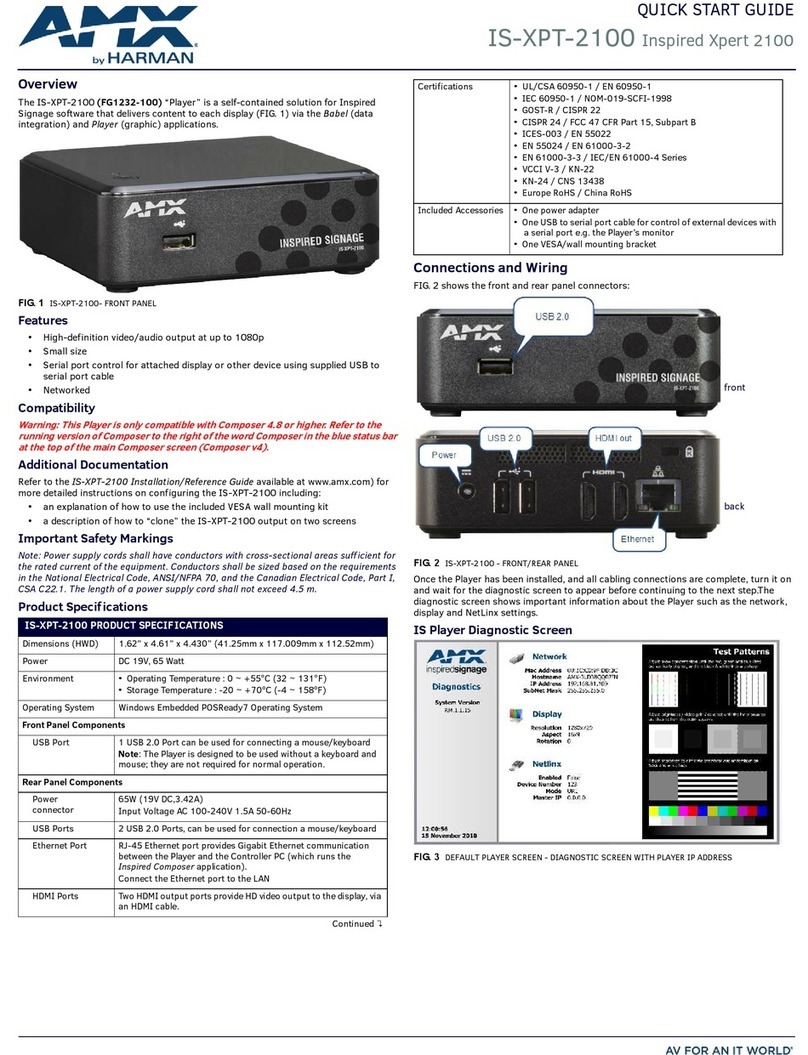
AMX
AMX IS-XPT-2100 quick start guide

ELECTRO BRAND
ELECTRO BRAND MP4316MO user manual
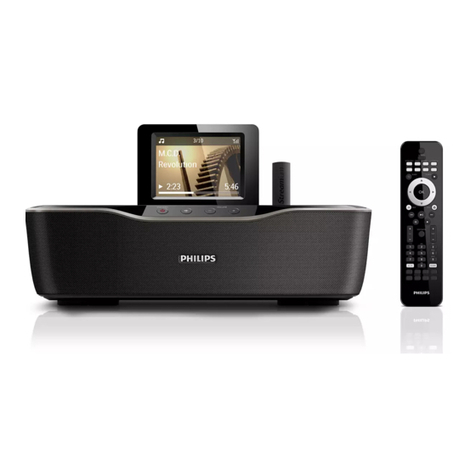
Philips
Philips Streamium NP3700/12 quick start guide
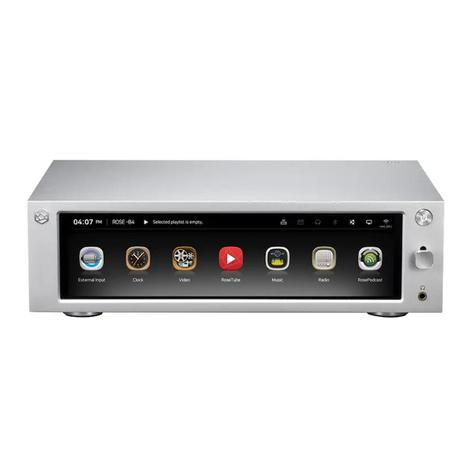
Rose electronics
Rose electronics RS201E user manual

Philips
Philips GoGEAR SA4VD404 quick start guide
